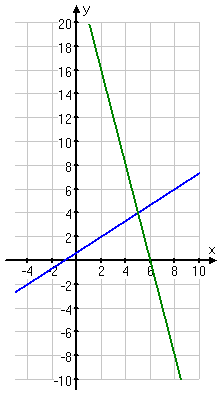Hi Everyone! Today in class we reviewed how to solve systems of equations.
A system of equations is two or more equations using the same variables and solutions to systems of equations are values for the variables that make all of the equations true.
There are three ways to solve systems of equations; substitution, elimination, and graphing.
Substitution:
Here are the book's steps for substitution
1. Solve one of the equations for a variable x in terms of the other variable y.
2. Plug the expression for x into the other equation. Now this equation will only have y's in it.
3. Solve the equation for y.
4. Plug the y value into the original equation from step 1 and solve for x.
Here's a sample problem using Substitution.
x+y = 6
x+2y = 3
Start by solving the first equation for x:
x = 6-y
Then substitute that expression for x in the second equation and solve for y:
(6-y)+2y = 3
6+y = 3
y = -3
Plug -3 into one of the original equations and solve for x:
x+(-3) = 6
x = 9
So, x = 9 and y = -3 are the solutions!
Elimination:
We didn't need to use elimination in our homework, but here's a sample problem anyway.
2x + y = 9
3x – y = 16
Start by 'adding' the equations because the y's will cancel out:
2x + y = 9
3x – y = 165x = 25
x = 5
Then plug x into one of the original equations:
2(5) + y = 9
10 + y = 9
y = –1
The solutions to this system are x = 5 and y = -1
Graphing:
To solve by graphing, you graph both of the equations and where they intersect are the solutions.
2x – 3y = –2
4x + y = 24
First solve each equation for y:
2x – 3y = –2
2x + 2 = 3yy = (2/3)x + (2/3)
4x + y = 24
y = –4x + 24
Next, graph the equations:

From this graph you can see that the intersect is (5,4).
So, the solutions to this system are x = 5 and y = 4.
That's basically it for solving systems of equations.
-Olivia R
No comments:
Post a Comment